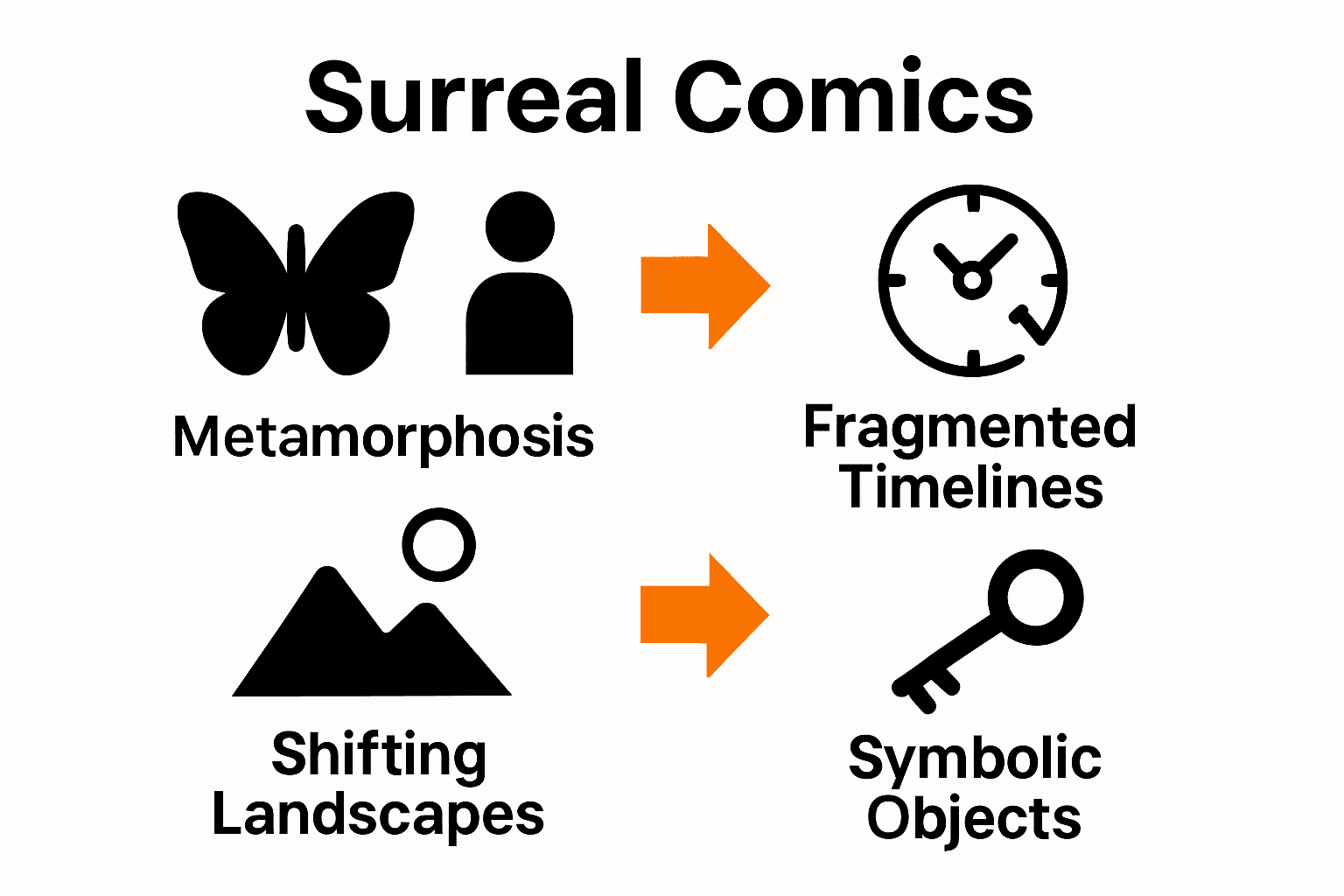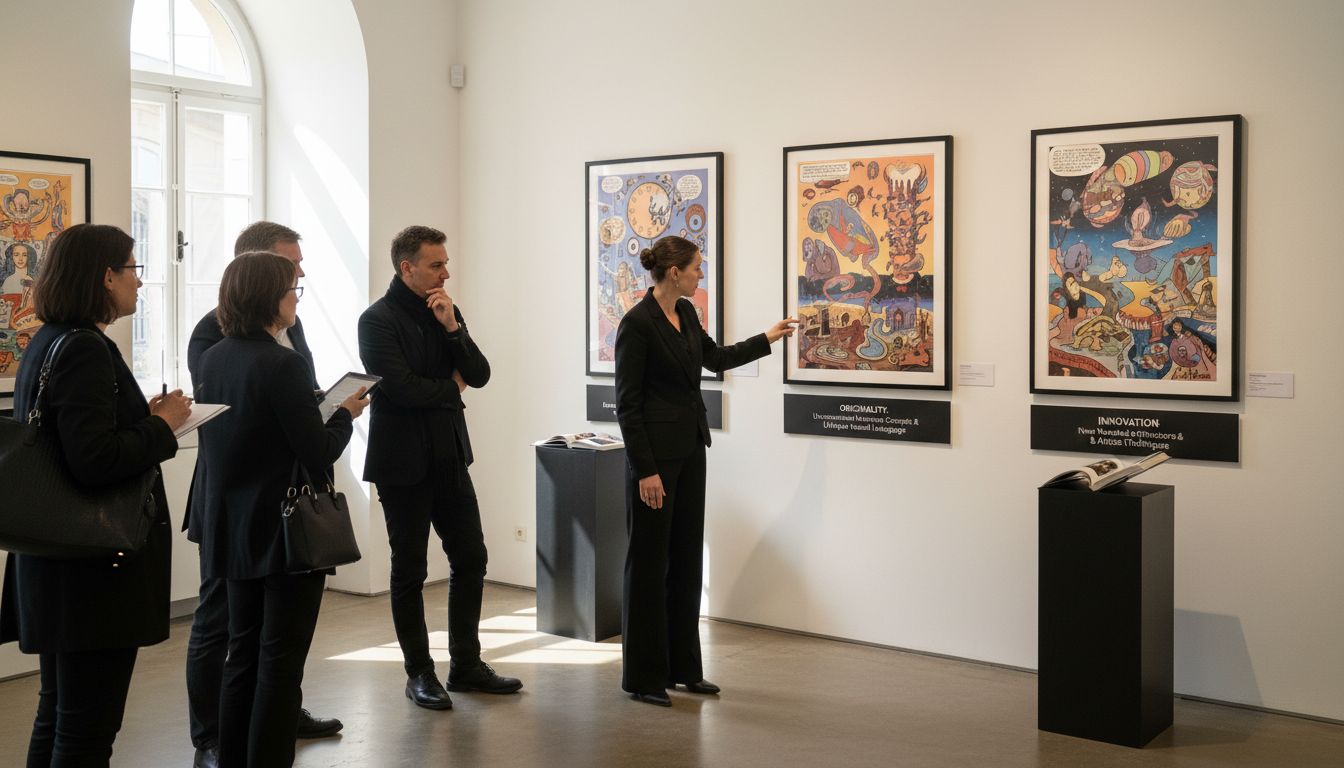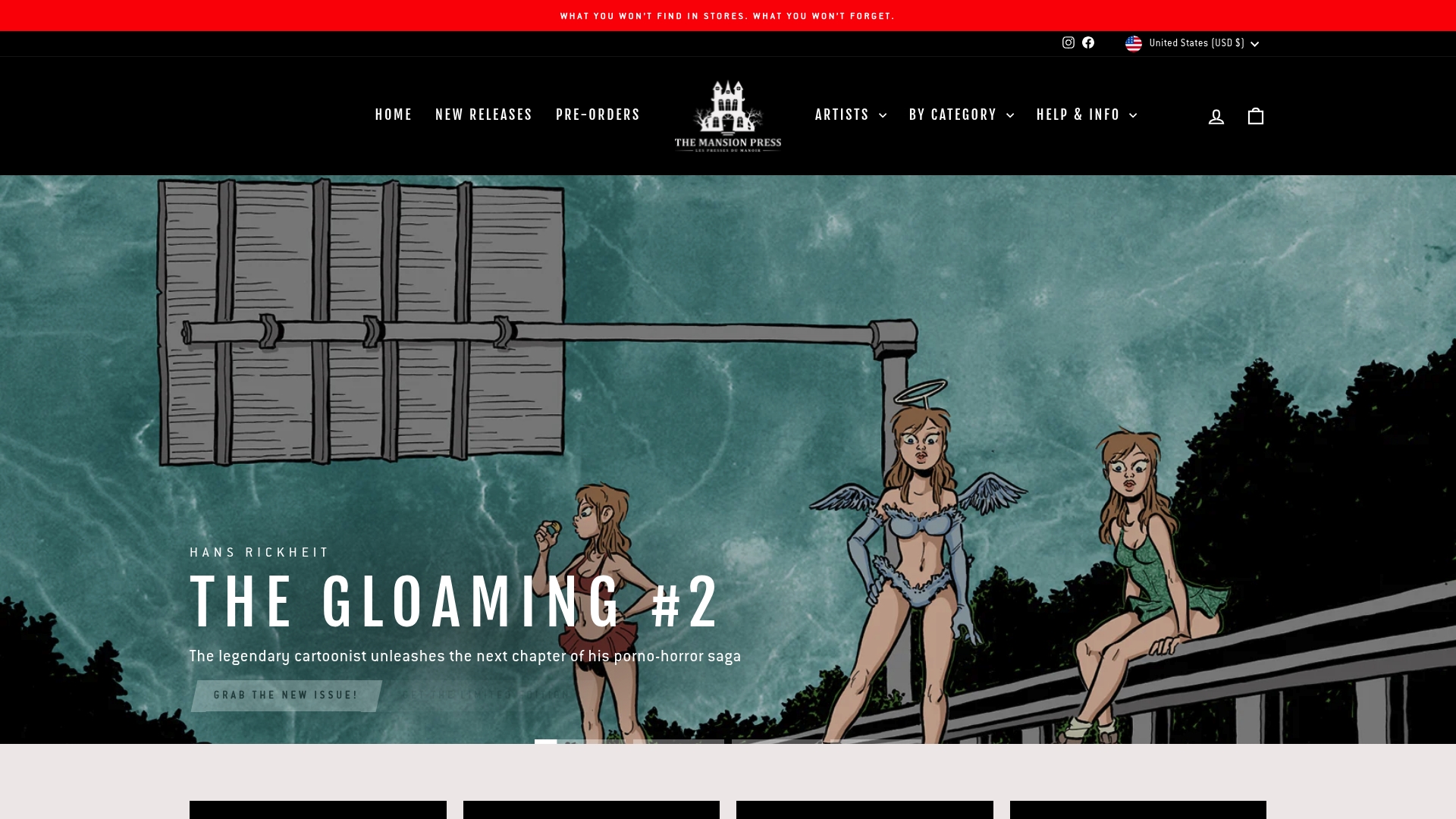Surreal Comics Explained: Techniques, Themes, Impact
Over 100 years ago, artists began breaking the rules that defined art and storytelling, giving birth to what we now recognize as surreal comics. These works blend unpredictable narratives with visuals that seem to leap from dreams, offering readers a gateway into pure imagination. As the influence of surrealism expanded from painting and literature into comics, fans and collectors found themselves drawn to stories where ordinary logic does not apply and every page invites fresh interpretation.
Table of Contents
- Defining Surreal Comics And Their Origins
- Major Styles And Artistic Approaches
- Recurring Motifs And Narrative Devices
- Influential Surreal Comic Creators Worldwide
- Collecting And Evaluating Surreal Comic Art
Key Takeaways
| Point | Details |
|---|---|
| Surreal Comics Challenge Norms | Surreal comics blur the lines of traditional narrative, embracing fragmented storytelling and dreamlike imagery to explore the subconscious. |
| Diverse Artistic Styles | Various styles like ligne claire and silent comics push visual representation boundaries, encouraging unique narrative expressions. |
| Key Motifs and Devices | Recurring motifs such as metamorphosis and temporal distortion enhance psychological depth, creating immersive, non-linear experiences. |
| Evaluation Criteria for Collectors | Collectors should assess surreal comics based on originality, emotional resonance, and narrative innovation, rather than just aesthetics. |
Defining Surreal Comics and Their Origins
Surreal comics represent a unique artistic expression that transcends traditional narrative boundaries, blending imaginative storytelling with dreamlike visual landscapes. Emerging from the broader Surrealist movement of the early 20th century, these comics challenge readers’ perceptions by disrupting conventional storytelling techniques and exploring the subconscious mind.
According to research in Surrealism, Science Fiction and Comics, surreal comics draw profound inspiration from the Surrealist art and literary movements, which sought to liberate creativity from rational constraints. These comics deliberately reject linear storytelling, instead embracing fragmented narratives, unexpected visual juxtapositions, and psychological exploration that mirror the unpredictable nature of dreams.
The origins of surreal comics can be traced to several key artistic developments. Early 20th-century movements like Dadaism and Surrealism provided critical groundwork, encouraging artists to challenge representational art and explore the realm of the unconscious. Understanding Surrealism in Graphic Novels highlights how comic artists began experimenting with non-linear storytelling, using visual metaphors and symbolic imagery to communicate complex emotional and psychological states.
Key characteristics of surreal comics include:
- Dreamlike imagery that defies physical logic
- Narrative structures that resist traditional plot progression
- Visual metaphors that represent psychological states
- Deliberate disruption of viewer expectations
- Exploration of unconscious themes and symbolic representations
By breaking traditional storytelling conventions, surreal comics invite readers into a world where imagination supersedes rational explanation, creating deeply personal and emotionally resonant experiences that challenge our understanding of narrative art.
Major Styles and Artistic Approaches
Surreal comics encompass a diverse range of artistic styles that challenge traditional visual storytelling, each offering unique approaches to narrative and artistic expression. These styles are characterized by their radical departure from conventional comic book aesthetics, pushing the boundaries of visual representation and psychological exploration.
One notable approach is the ligne claire style, which Wikipedia describes as a drawing technique featuring clear, strong lines and flat colors. While traditionally associated with more realistic comics, surreal artists adapt this technique to create stark, dreamlike imagery that emphasizes visual precision and emotional abstraction. This approach allows artists to render bizarre, impossible scenes with remarkable clarity, making the unreal feel tangibly present.
How to Identify Comic Art Styles highlights several distinctive surreal comic styles, including:
- Dreamscape Narrative Style: Prioritizing psychological landscapes over physical reality
- Symbolic Fragmentation: Breaking visual elements into metaphorical representations
- Automatic Drawing Technique: Spontaneous, subconscious imagery creation
- Collage and Mixed Media Approach: Combining disparate visual elements to disrupt narrative expectations
Another fascinating technique is the silent comic method, which Wikipedia explains relies entirely on visual storytelling without dialogue. In surreal comics, this approach becomes particularly powerful, allowing artists to communicate complex emotional states and abstract concepts through pure imagery, bypassing linguistic constraints and inviting multiple interpretations.
These artistic approaches transform comics from mere sequential art into profound psychological explorations, inviting readers to engage with narratives that exist beyond literal representation and conventional storytelling boundaries.
Here’s a summary of major surreal comic styles and their defining features:
| Style or Approach | Key Characteristics | Example Techniques |
|---|---|---|
| Ligne Claire | Clear lines, flat colors, precise imagery | Emphasizes clarity in dreamlike scenes |
| Dreamscape Narrative | Psychological landscapes over realism | Shifts in perspective, ambiguous space |
| Symbolic Fragmentation | Visual metaphors, broken elements | Objects/persons as symbols, abstraction |
| Automatic Drawing | Spontaneous, subconscious images | Stream-of-consciousness line work |
| Collage/Mixed Media | Combines varied visual elements | Mixed materials, fragmented visuals |
| Silent Comic | No dialogue, pure visual story | Relies on emotion and symbolism |
Recurring Motifs and Narrative Devices
Surreal comics thrive on narrative disruption, employing a rich arsenal of motifs and devices that challenge readers’ fundamental expectations of storytelling. These artistic strategies transform comic narratives from linear experiences into complex psychological landscapes that defy conventional logic.
According to Wikipedia’s exploration of surreal humour, these comics frequently utilize illogical scenarios and bizarre juxtapositions to subvert audience expectations. The resulting narratives become intricate psychological puzzles where reality bends, characters morph unexpectedly, and visual metaphors replace traditional plot progression. Understanding Narrative Techniques in Graphic Novels further illuminates how these techniques deconstruct traditional storytelling.
Key recurring motifs in surreal comics include:
- Metamorphosis: Characters transforming physically or metaphorically
- Dreamscape Landscapes: Environments that shift and breathe with psychological energy
- Temporal Distortion: Non-linear time representations
- Symbolic Object Transformation: Mundane items gaining extraordinary significance
- Fragmented Self-Representation: Characters existing in multiple states simultaneously
The Comedy article highlights how absurdity and illogic create unexpected narrative experiences. In surreal comics, this translates to storytelling that prioritizes emotional truth over literal representation, inviting readers to experience narratives as immersive psychological journeys rather than straightforward plot progressions.
By embracing these narrative devices, surreal comics transcend traditional storytelling, creating immersive experiences that challenge perception, provoke emotional responses, and invite multiple interpretations of reality itself.

Influential Surreal Comic Creators Worldwide
Surreal comics have been shaped by extraordinary artists who challenge conventional storytelling, transforming the medium into a profound psychological exploration. These creators push artistic boundaries, reimagining visual narratives through unique perspectives and groundbreaking techniques.
7 Notable Cult Comic Authors Every Fan Should Know highlights the diversity of innovative creators who have redefined comic art. Among these pioneering artists, Wikipedia’s profile of Yuichi Yokoyama stands out as a prime example of avant-garde manga, characterized by abstract compositions that fundamentally challenge traditional narrative structures. Yokoyama’s work exemplifies how surreal comic creators deconstruct visual storytelling, transforming comics from sequential art into immersive psychological experiences.
Key influential surreal comic creators include:
- David Lynch: Blending cinematic and graphic narrative techniques
- David Mazzucchelli: Experimenting with visual metaphor and deconstruction
- Chris Ware: Exploring complex emotional landscapes through intricate design
- Yuichi Yokoyama: Pioneering abstract manga narratives
- Dave McKean: Integrating mixed media and dreamlike imagery
The Ligne claire tradition, exemplified by Hergé, also influenced many surreal comic artists, demonstrating how even traditional styles can be transformed through innovative storytelling. These creators share a fundamental commitment to expanding the boundaries of visual narrative, challenging readers to engage with comics as complex psychological and artistic expressions rather than mere entertainment.
By continuously reinventing visual language, these artists have elevated surreal comics from a niche genre to a powerful medium of personal and collective imagination.
Collecting and Evaluating Surreal Comic Art
Collecting surreal comic art requires a nuanced approach that goes beyond traditional art evaluation, demanding a deep understanding of the medium’s unique psychological and artistic language. Serious collectors must develop a sophisticated eye for distinguishing between innovative artistic expression and mere visual novelty.
Recognizing Original Comic Art emphasizes the importance of understanding an artwork’s contextual and technical foundations. According to LinkedIn’s insights on educational comic art styles, evaluating surreal comic art involves examining several critical dimensions of artistic achievement.
Key evaluation criteria for surreal comic art include:
- Conceptual Originality: Uniqueness of psychological narrative
- Technical Complexity: Sophistication of visual metaphor
- Emotional Resonance: Depth of psychological exploration
- Narrative Innovation: Disruption of traditional storytelling conventions
- Visual Execution: Precision of abstract imagery
Silent comics provide a fascinating lens for understanding visual storytelling, demonstrating how surreal comic art can communicate profound meanings without traditional narrative structures. Collectors should look beyond surface-level aesthetics, seeking works that challenge perceptual boundaries and invite multiple interpretations.
Successful surreal comic art collection requires an approach that balances intellectual curiosity with emotional sensitivity, recognizing that these works are not mere decorative objects but complex psychological landscapes waiting to be explored.

Discover and Own the Magic of Surreal Comics Today
The world of surreal comics invites you into dreamlike narratives filled with symbolic imagery and emotional depth that defy conventional storytelling. If you are captivated by the innovative techniques and psychological landscapes highlighted in “Surreal Comics Explained: Techniques, Themes, Impact” you can explore exclusive surreal comic art and limited editions that push creative boundaries. With a wide range of original artworks and collector’s editions available, The Mansion Press helps you connect with groundbreaking creators who transform comic art into immersive psychological experiences.

Step into a collection designed for passionate art enthusiasts and collectors seeking pieces that blend conceptual originality with captivating visual execution. Don’t miss the chance to own rare surreal comics and artist collaborations that challenge imagination and emotion. Visit The Mansion Press now to browse unique surreal comic selections and pre-order upcoming releases. Unlock the story behind the images and add truly exceptional art to your collection today.
Frequently Asked Questions
What are surreal comics?
Surreal comics are a unique form of artistic expression that blend imaginative storytelling with dreamlike visual landscapes, often challenging traditional narrative structures to explore the subconscious mind.
What are the key characteristics of surreal comics?
Key characteristics include dreamlike imagery, non-linear narratives, visual metaphors representing psychological states, disruption of viewer expectations, and exploration of unconscious themes.
How do different artistic styles contribute to surreal comics?
Various artistic styles, such as ligne claire and silent comics, transform traditional comic book aesthetics, offering radical narrative and visual approaches that emphasize emotional depth and abstract representation.
What are some common motifs found in surreal comics?
Common motifs include metamorphosis, dreamscape landscapes, temporal distortion, symbolic object transformation, and fragmented self-representation, all of which create complex psychological narratives.

